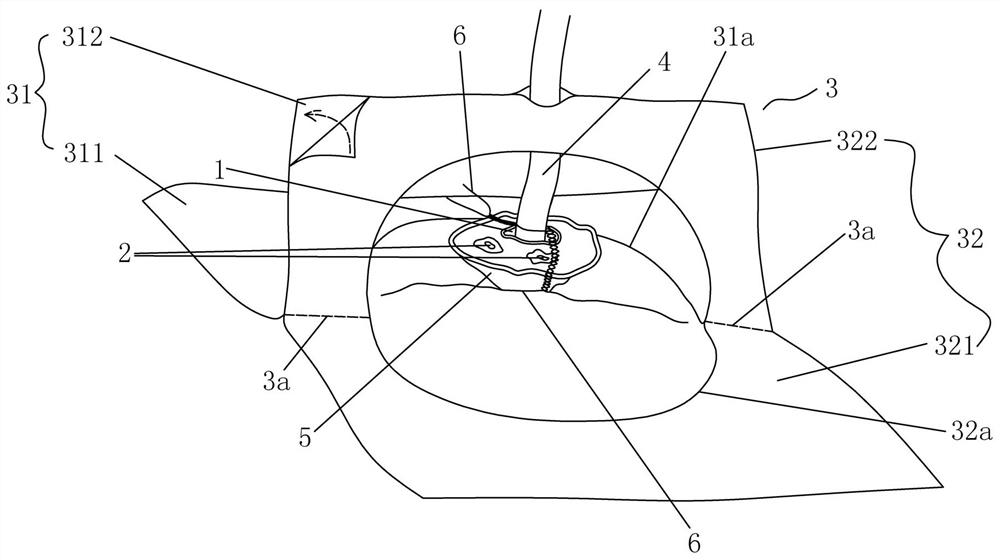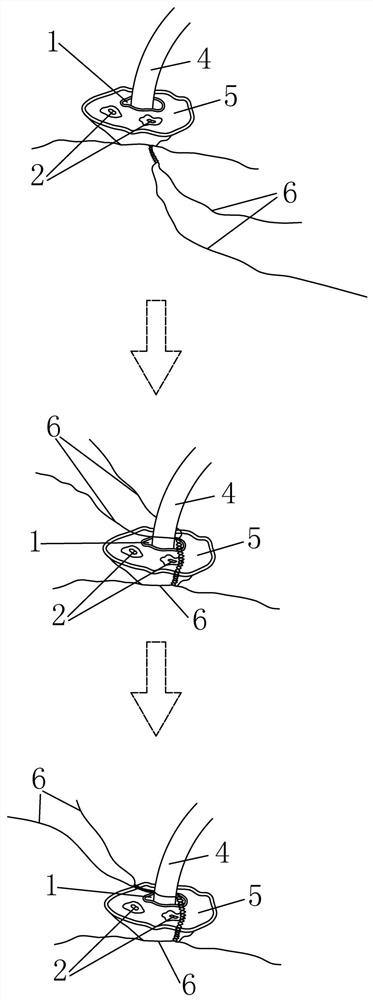A new bridge-type fixation structure for umbilical arteriovenous catheterization in neonates
A fixed structure, arteriovenous technology, used in catheters, dressings, other medical devices, etc., can solve problems such as being unfavorable for covering gauze protection, easy to irritate the skin, and unfavorable for patient treatment.
- Summary
- Abstract
- Description
- Claims
- Application Information
AI Technical Summary
Problems solved by technology
Method used
Image
Examples
specific Embodiment 1
[0024] Such as figure 1 As shown, the present invention relates to a novel bridge-type fixation method for neonatal umbilical arteriovenous catheterization. The required instruments for the fixation method include: punching forceps, hydrocolloid dressing 3 and scissors. One side of this hydrocolloid dressing 3 is provided with protective paper, the umbilical part 5 of newborn (wherein, the inner diameter of umbilical vein 1 is larger than umbilical artery 2, and the number is one; The inner diameter of umbilical artery 2 is smaller than umbilical vein 1, and the number is one 2) The umbilical arteriovenous catheter 4 has been pre-set; the operation steps of the bridge fixation method are as follows:
[0025] 1) Prepare the apparatus, specifically, use a high-temperature and high-pressure steam sterilizer to sterilize the punching forceps, scissors, and die cutters for 16 minutes at a temperature of 121° C. and a pressure of 2.0 Bar. , and then dry the punching pliers, scisso...
specific Embodiment 2
[0031] Such as figure 1 As shown, the present invention relates to a novel bridge-type fixation method for neonatal umbilical arteriovenous catheterization. The required instruments for the fixation method include: punching forceps, hydrocolloid dressing 3 and scissors. One side of this hydrocolloid dressing 3 is provided with protective paper, the umbilical part 5 of newborn (wherein, the inner diameter of umbilical vein 1 is larger than umbilical artery 2, and the number is one; The inner diameter of umbilical artery 2 is smaller than umbilical vein 1, and the number is one 2) The umbilical arteriovenous catheter 4 has been pre-set; the operation steps of the bridge fixation method are as follows:
[0032] First, prepare the instruments. Specifically, use a high-temperature and high-pressure steam sterilizer to sterilize the punching forceps, scissors, and die cutters for 10 minutes at a temperature of 128°C and a pressure of 2.1 Bar. , and then dry the punching pliers, sc...
specific Embodiment 3
[0038] Such as figure 1 As shown, the present invention relates to a novel bridge-type fixation method for neonatal umbilical arteriovenous catheterization. The required instruments for the fixation method include: punching forceps, hydrocolloid dressing 3 and scissors. One side of this hydrocolloid dressing 3 is provided with protective paper, the umbilical part 5 of newborn (wherein, the inner diameter of umbilical vein 1 is larger than umbilical artery 2, and the number is one; The inner diameter of umbilical artery 2 is smaller than umbilical vein 1, and the number is one 2) The umbilical arteriovenous catheter 4 has been pre-set; the operation steps of the bridge fixation method are as follows:
[0039] First, prepare the instruments. Specifically, use a high-temperature and high-pressure steam sterilizer to sterilize the punching pliers, scissors, and die cutters for 6 minutes at a temperature of 134°C and a pressure of 2.2 Bar. , and then dry the punching pliers, scis...
PUM
 Login to View More
Login to View More Abstract
Description
Claims
Application Information
 Login to View More
Login to View More - R&D
- Intellectual Property
- Life Sciences
- Materials
- Tech Scout
- Unparalleled Data Quality
- Higher Quality Content
- 60% Fewer Hallucinations
Browse by: Latest US Patents, China's latest patents, Technical Efficacy Thesaurus, Application Domain, Technology Topic, Popular Technical Reports.
© 2025 PatSnap. All rights reserved.Legal|Privacy policy|Modern Slavery Act Transparency Statement|Sitemap|About US| Contact US: help@patsnap.com


